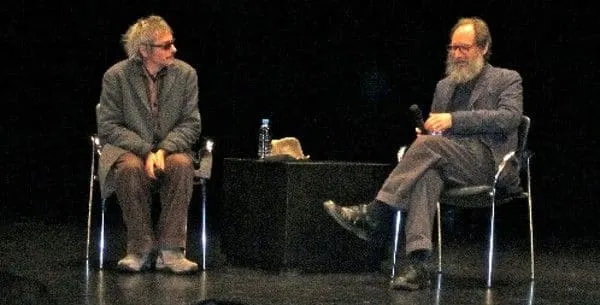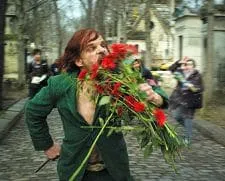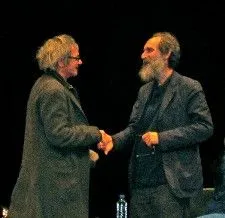 |
| Leos Carax and The New Yorker film critic Richard Brody Photo: Anne-Katrin Titze |
On a chilly rainy evening on Tuesday, February 26, at the French Institute Alliance Française in New York City as part of their series When Boy Meets Girl: The Cinema of Leos Carax, the filmmaker's first US retrospective, Carax came for a Q&A with Richard Brody, film critic for The New Yorker. Following a screening of Holy Motors, the two men conversed on stage, dressed in coats of brown and grey, sunglasses and beard covering the top and bottom half of their respective faces respectively, resembling Samuel Beckett characters not waiting for Godot.
Brody almost started with the beginning.
Richard Brody: You had written as a critic for a little while at Cahiers Du Cinéma?
Leos Carax: A very little while. I was not a critic. I wrote a few things, but it was not my thing.
RB: Were you a cinephile growing up, watching lots and lots of movies?
LC: Not really… I left school early. I moved to Paris. I didn't know anybody in Paris.
 |
| Leos Carax Photo: Anne-Katrin Titze |
Carax, via silent movies, discovered that "there had to be a man behind a film, there had to be someone behind the machine. And I wanted to be that man." He talked about his shyness and love of the pinball machine. "I exchanged a pinball machine for a camera." He never went to film school.
RB: Was it more difficult making a film after a decade?
LC: No, I've made so few films that each film feels like the first and the last.
Carax regular Denis Lavant, if you want to call him that, was also in the Tokyo! triptych short Merde (2008) as the fantastic man from the sewers.
RB: From the very start you were working with Denis Lavant. How did you connect with him? How did you find him?
LC: He was an actor. He did street theatre. Mime. Circus. I imagined Boy Meets Girl, but I couldn't find the boy. So we had to delay the shoot. One day we went to the unemployment agency and they had a file for actors… That's how we met. I was intrigued. I liked to film him. I didn't know. I don't do rehearsals, I don't do tests. Then we started…. Then I made a second film (Bad Blood/Mauvais sang in 1986 with Lavant) where he was much more physical.
And then a third one (Les Amants du Pont Neuf, in 1991). He got better and better. Now, there's nothing he can't play. I was very lucky to find him. I don't know him. He lives a block away from me. When I see him on the street we say hello. But we're not friends. I don't think we talk much, even on the set. Costumes, wigs in this film, and how the character walks and talks. In each film I put something where the actor has to work towards something physical. Where the actor has to jump from an aeroplane. Or they have to dance, or water ski, something difficult. I like to do motion… and whatever the actors do, I do too. If they have to jump from an aeroplane, I jump with them. It helps. That's why this film starts with 19th century cinematography. When I film with Denis, I have the same pleasure.
 |
| Denis Lavant as Merde in Holy Motors |
RB: At the end of Merde, a short film from the compilation Tokyo!, you tease us with Merde coming to the United States - Merde in USA! Have you been tempted to make films here? Has the idea of a Hollywood film been something that you dreamed of?
LC (after a long pause): Make a film in America, yes. In English, yes. I don't think I could do a film in Hollywood. I don't think it would work.
About his 1999 film Pola X, based on Melville's Pierre or the Ambiguities:
LC: I always thought this book was written for me. It was like a brother.
Carax, born in 1960, had his first feature Boy Meets Girl released in 1984.
LC: I just learned this weekend that when Stanley Donen made Singin' in the Rain (1952), he was 22. (Actually, On the Town was Stanley Donen's first film released in 1949, when he was 25).
Brody asked about the changes, filming with a digital camera and a much smaller crew.
LC: It's very sad to go from film to digital. It's not ready. I think they sold it like a pharmacy - they want to sell you medicine for a sickness that doesn't exist.
RB: What makes film hard?
 |
| Leos Carax and Richard Brody Photo: Anne-Katrin Titze |
After seeing Holy Motors at the 50th New York Film Festival press screening last October, I asked Carax about a particular end credit thanks. He included Henry James. I asked him is that Henry James Ford, Mr Motorman, Henry James, the author, or a bit of both?
Carax replied at that time: I thank Henry James for the scene in the hotel room, that I stole from Portrait Of A Lady… This particular scene is the most beautiful scene ever written. This was the perfect opportunity to ask him a follow up question about Portrait of a Lady and the beautiful scene in the Hotel Raphael, which is one of Monsieur Oscar's many assignments.
 |
| Kylie Minogue "was a very pure person, like a child" |
He compared casting to falling in love and that it's tough to plan for something like that "in the next two months."
LC: There are very few people I want to film. Less and less people. I don't know why. I find it very hard to find someone you really feel you have to film.
On Kylie Minogue in Holy Motors: LC: I felt she was a very pure person, like a child. And she's very small. Denis is my size, he's not very tall. I thought, I would love to film this tiny couple in this huge (empty) department store. That's why she's here.
On feeling trapped in coincidences:
LC: I guess the feelings of this film were - the fatigue of being oneself. Which happens. It has to happen. You cannot live a long life without getting tired of being yourself. The other feeling is this need to reinvent yourself. You have to. I think the film started that way. Metaphors are in the eye of the beholder.
 |
| Carax and Brody shake hands Photo: Anne-Katrin Titze |
The Man Makes the Clothes: Pierre Cardin in Film from March 5–26, 2012 will be the next series on CinémaTuesdays held at the French Institute Alliance Française in New York. In addition, on March 8, the exhibition Manifesto opens, co-curated by Vogue Style Editor at Large Elisabeth von Thurn und Taxis and Antoine Guerrero, Director of Visual Arts at FIAF, with a series of Fashion Talks moderated by Pamela Golbin, Chief Curator of Fashion and Textiles at Les Arts Décoratifs in Paris.
























